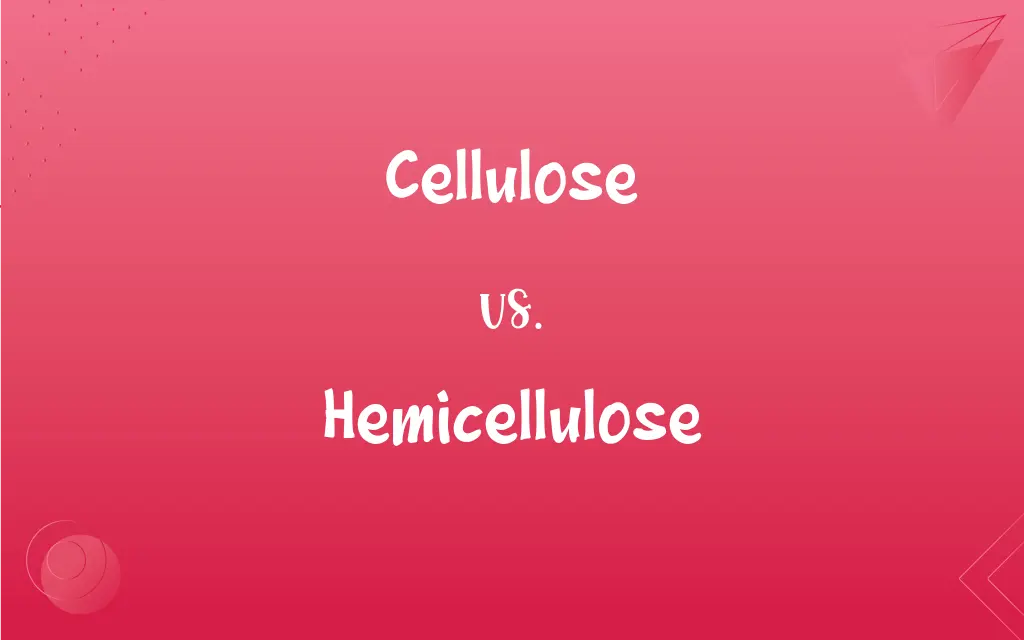Cellulose vs. Hemicellulose: What's the Difference?
Edited by Aimie Carlson || By Harlon Moss || Published on November 16, 2023
Cellulose is a linear, crystalline polymer of glucose units. Hemicellulose is a branched, amorphous polymer of various sugars.

Key Differences
Cellulose is the primary structural component found in the cell walls of plants, giving them rigidity and strength. On the other hand, hemicellulose acts as a filler material in plant cell walls, complementing the function of cellulose by filling spaces and linking fibers.
In its structure, cellulose is a linear polymer made up of glucose molecules linked end-to-end. This linear arrangement enables it to form crystalline structures, lending strength to plants. In contrast, hemicellulose consists of various sugar monomers and is branched, resulting in an amorphous and non-crystalline structure.
Cellulose is more resistant to chemical and microbial degradation due to its crystalline nature. This is why it's a primary component in materials like cotton and paper. However, hemicellulose, with its varied sugar components and amorphous structure, is more easily hydrolyzed and degraded.
In industrial applications, cellulose can be chemically modified or used in its natural form for materials and biofuels. Hemicellulose, being less stable, often requires pre-treatment or conversion into simpler sugars for similar applications.
While cellulose is primarily composed of glucose units, hemicellulose is diverse in its composition, containing sugars like xylose, mannose, and galactose. This varied composition makes hemicellulose a heterogeneous group, differing from the uniformity of cellulose.
ADVERTISEMENT
Comparison Chart
Composition
Made of glucose units.
Made of various sugars like xylose, mannose, galactose, etc.
Structure
Linear and crystalline.
Branched and amorphous.
Role in Plants
Primary structural component.
Filler material, linking fibers.
Degradability
Resistant to degradation.
Easily hydrolyzed and degraded.
Industrial Applications
Used in materials like cotton, paper, and biofuels.
Requires pre-treatment or conversion for similar applications.
ADVERTISEMENT
Cellulose and Hemicellulose Definitions
Cellulose
The main substance in the cell walls of plants.
Cellulose gives rigidity to plants, enabling them to stand upright.
Hemicellulose
A heterogeneous group of polysaccharides found in plant cell walls.
The presence of hemicellulose complements the structural role of cellulose in plants.
Cellulose
A polysaccharide consisting of glucose monomer units.
The breakdown of cellulose releases glucose, which can be used as an energy source.
Hemicellulose
A substance that fills spaces in plant cell walls.
Hemicellulose acts as a matrix material, binding cellulose fibers together.
Cellulose
A glucose polymer that forms plant cell walls.
Cotton is almost pure cellulose, making it a durable material.
Hemicellulose
A complex carbohydrate that is more easily degraded than cellulose.
The breakdown of hemicellulose releases various sugars, adding to its complexity.
Cellulose
A complex carbohydrate used in making paper and textiles.
The cellulose content in wood makes it suitable for paper production.
Hemicellulose
A less crystalline form of plant polysaccharide.
Because of its varied composition, hemicellulose differs from the uniform structure of cellulose.
Cellulose
An organic compound that is the chief component of plant fibers.
The high cellulose content in bamboo makes it a sustainable choice for fabrics.
Hemicellulose
A branched polymer containing various sugar monomers.
Hemicellulose can be hydrolyzed more easily than cellulose due to its amorphous structure.
Cellulose
A polysaccharide, (C6H10O5)n, that is composed of glucose monomers and is the main constituent of the cell walls of plants. It is used in the manufacture of numerous products, including paper, textiles, pharmaceuticals, and insulation.
Hemicellulose
Any of several branched polysaccharides that are composed of a variety of different monosaccharides and form a matrix with cellulose and lignin or pectin in plant cell walls. It is produced commercially from corn fiber.
Cellulose
A complex carbohydrate that forms the main constituent of the cell wall in most plants and is important in the manufacture of numerous products, such as paper, textiles, pharmaceuticals, and explosives.
Hemicellulose
(carbohydrate) A mixture of several plant polysaccharides, of smaller molecular weight than cellulose, that are soluble in dilute alkali; they are involved in the manufacture of paper, and are used in the production of furfural and ethanol.
FAQs
Is hemicellulose linear like cellulose?
No, hemicellulose is branched, unlike the linear cellulose.
Is cellulose used in textile production?
Yes, cellulose is a key component in textiles like cotton.
Which is more resistant to degradation, cellulose or hemicellulose?
Cellulose is more resistant than hemicellulose.
What is the primary component of plant cell walls, cellulose or hemicellulose?
Cellulose is the primary component.
What sugars can be found in hemicellulose?
Hemicellulose contains sugars like xylose, mannose, and galactose.
Why is hemicellulose considered amorphous?
Hemicellulose's branched structure and varied composition give it an amorphous nature.
Which is a primary structural component in plants, cellulose or hemicellulose?
Cellulose is the primary structural component in plants.
Are there industrial applications for hemicellulose?
Yes, after pre-treatment or conversion, hemicellulose has various applications.
Do both cellulose and hemicellulose consist of glucose units?
Only cellulose consists primarily of glucose; hemicellulose contains various sugars.
Which has a more varied composition, cellulose or hemicellulose?
Hemicellulose has a more varied composition than cellulose.
Are cellulose and hemicellulose both present in wood?
Yes, both are major components of wood.
Can cellulose be digested by humans?
No, humans lack the enzyme to digest cellulose.
What makes cellulose suitable for fabric production?
Its linear, crystalline structure provides strength and durability to fabrics.
Does hemicellulose have a uniform structure like cellulose?
No, hemicellulose has a diverse structure, unlike the uniform cellulose.
Can hemicellulose be easily hydrolyzed?
Yes, hemicellulose can be more easily hydrolyzed than cellulose.
Is cellulose a crystalline structure?
Yes, cellulose forms a crystalline structure due to its linear arrangement.
Why is cellulose important in the paper industry?
Cellulose provides the necessary strength and structure to paper products.
How does cellulose contribute to plant rigidity?
Cellulose forms crystalline structures, giving plants strength and rigidity.
Does hemicellulose bind with other components in plant cell walls?
Yes, hemicellulose acts as a matrix, binding with cellulose and other components.
Are both cellulose and hemicellulose carbohydrates?
Yes, both are complex carbohydrates or polysaccharides.
About Author
Written by
Harlon MossHarlon is a seasoned quality moderator and accomplished content writer for Difference Wiki. An alumnus of the prestigious University of California, he earned his degree in Computer Science. Leveraging his academic background, Harlon brings a meticulous and informed perspective to his work, ensuring content accuracy and excellence.
Edited by
Aimie CarlsonAimie Carlson, holding a master's degree in English literature, is a fervent English language enthusiast. She lends her writing talents to Difference Wiki, a prominent website that specializes in comparisons, offering readers insightful analyses that both captivate and inform.






































































